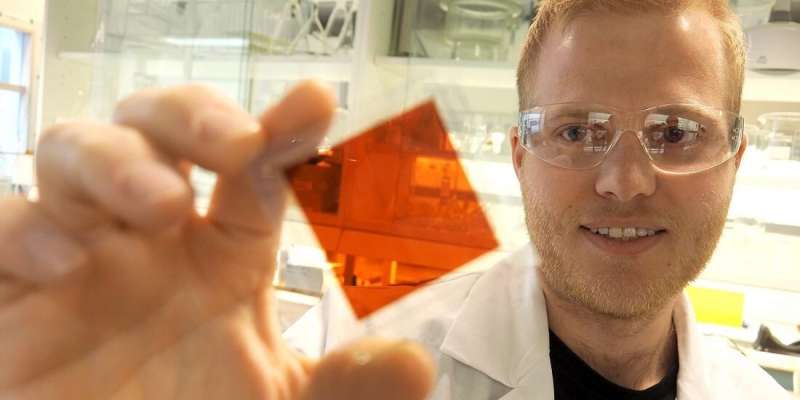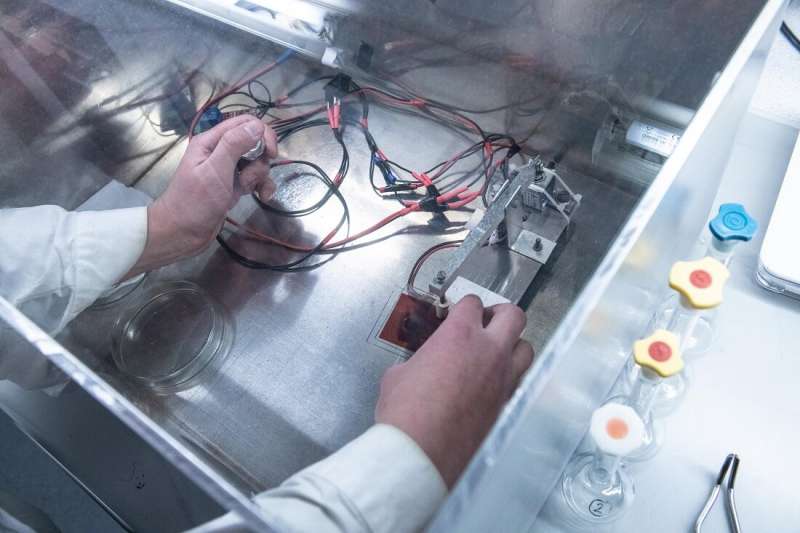The most beautiful solar cells are inspired by nature

Organic solar cells are usually less effective than silicon solar cells. But there is still a market for them—and they're beautiful and exciting.
Chemists at NTNU are working with a type of solar cell that is called an organic solar cell, made with a process that makes it dye-sensitized. The researchers have drawn their inspiration from molecules in nature that plants use when capturing sunlight, and have recreated similar structures in the lab.
In the race to make the most efficient solar cells for outdoor use, however, the dye-sensitized solar cells don't make the grade. Silicon solar cells are more effective for that purpose.
The organic solar cells work better when the light is dim, such as indoors, and the research discussed in this article applies to indoor solar cells.
Indoor benefits
Organic solar cells come into their own indoors. Compared to silicon-based solar cells, they are tremendously effective in indoor lighting conditions. They can also be made moldable, transparent or manufactured in different colors.
Today, organic solar cells based on green and blue dyes are in great demand. Businesses such as the Swiss company H.Glass are working to commercialize dye-sensitized solar cells that are integrated into buildings. Aesthetics are much more important in these applications.
Another possible indoor application for organic solar cells is to supply power to various components connected to the "Internet of Things," such as different sensors in smart homes. It is also conceivable that organic solar cells can be used to provide devices like tablets and laptops undying battery life and make charging unnecessary.
"We're continuing to research this technology even though other solar cells are more efficient for outdoor use. That's because we believe these solar cells have a future, and because the chemistry is incredibly exciting. After all, our field of study is organic reactions," says Audun Formo Buene, a recent Ph.D. graduate of NTNU's Department of Chemistry.
The work requires interdisciplinary research, combining organic chemistry, materials technology, electronics and physics. But what exactly are the researchers making?
Many types of cells
An organic solar cell is built a bit like a sandwich between two glass plates that conduct electricity: A thin layer of porous titanium oxide particles provides a large surface with room for many dyes. When they capture light, the dyes emit an electron and the circuit can be closed with an electrolyte solution.
Different types of organic solar cells abound. They use various organic materials to capture the sunlight: dye-sensitized solar cells, polymers or organic halide perovskites.

Perovskites take over
Another aspect of organic solar cells is that the current research provides important building blocks on the path to another potential solar cell revolution: the mineral perovskite.
Perovskites have a very specific crystal structure. The mineral has numerous uses and is often found in superconductors.
Replacing dye molecules with perovskite makes it possible to create highly efficient solar cells, although stability over time has been a challenge for this technology.
In laboratory experiments, measurements of perovskite solar cells have recently been shown to have efficiencies at the same level as silicon solar cells.
"Since the perovskite breakthrough, the competition between research communities has amped up. Everyone wants to be the first to create stable and efficient perovskite solar cells. But the NTNU research group is staying with the dye-based solar cells. With such strong interest now focused on perovskite, it means that there's less secrecy and more collaboration among research groups working with the other types of organic solar cells," says Buene.
Efficiency is important, regardless
Efficiency remains the most important factor for all solar cells. Buene and his colleagues' work is mainly focused on increasing efficiencies. The dye molecules need to be adapted to the light spectrum, but they also have to remain stable for several years inside the solar cell.
The research group at NTNU has worked extensively with a dye class that belongs to the phenothiazine group of organic compounds. The dye powders or crystals are often a beautiful deep shiny red color. But the research shows that there's little to gain from further developing cells with this type of dye, so the researchers have started to investigate another class of substance.
Doing puzzles with his own pieces
Buene has worked systematically: he studied different atomic groups, and changed the composition in different parts of the molecular structure. His goal is to understand what makes a dye good or bad, and how to make better dyes in the future. This is like a puzzle where he makes the puzzle pieces himself, before trying to find out whether—and if so where—they fit.
Much work remains to be done before the solar cells become efficient and cheap enough to release the technology into the public domain. However, several companies are working to commercialize the technology, and maybe one day you'll be able to have these solar cells in your living room.
More information: Audun Formo Buene et al. Auxiliary donors for phenothiazine sensitizers for dye-sensitized solar cells—how important are they really?, Journal of Materials Chemistry A (2019). DOI: 10.1039/C9TA00472F
Audun Formo Buene et al. Effect of furan π-spacer and triethylene oxide methyl ether substituents on performance of phenothiazine sensitizers in dye-sensitized solar cells, New Journal of Chemistry (2019). DOI: 10.1039/C9NJ01720H
Journal information: Journal of Materials Chemistry A
Provided by Norwegian University of Science and Technology





















